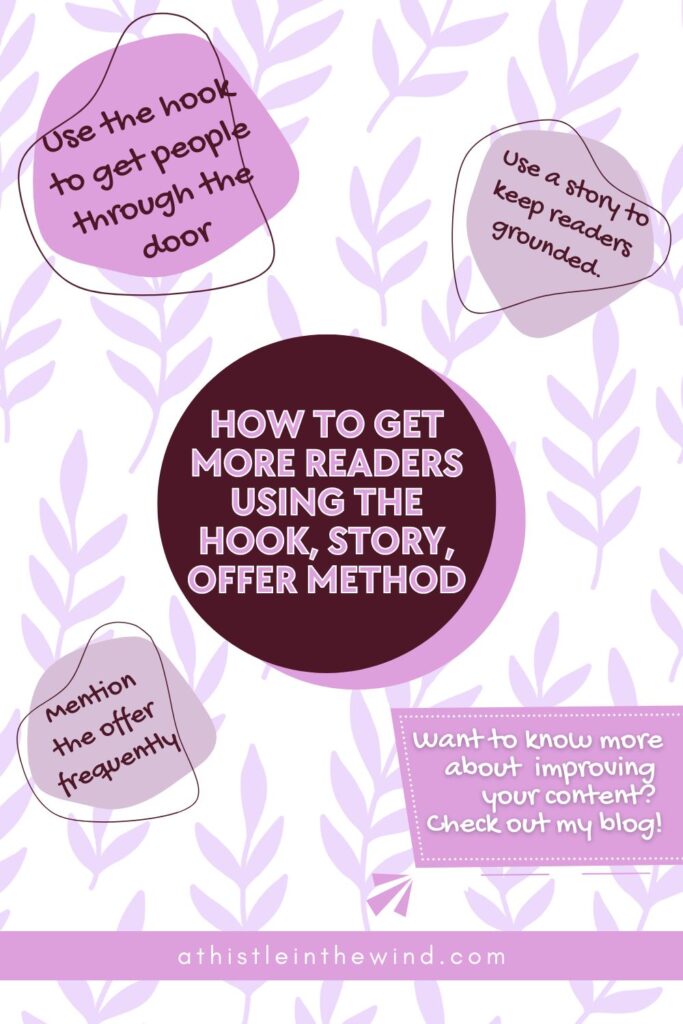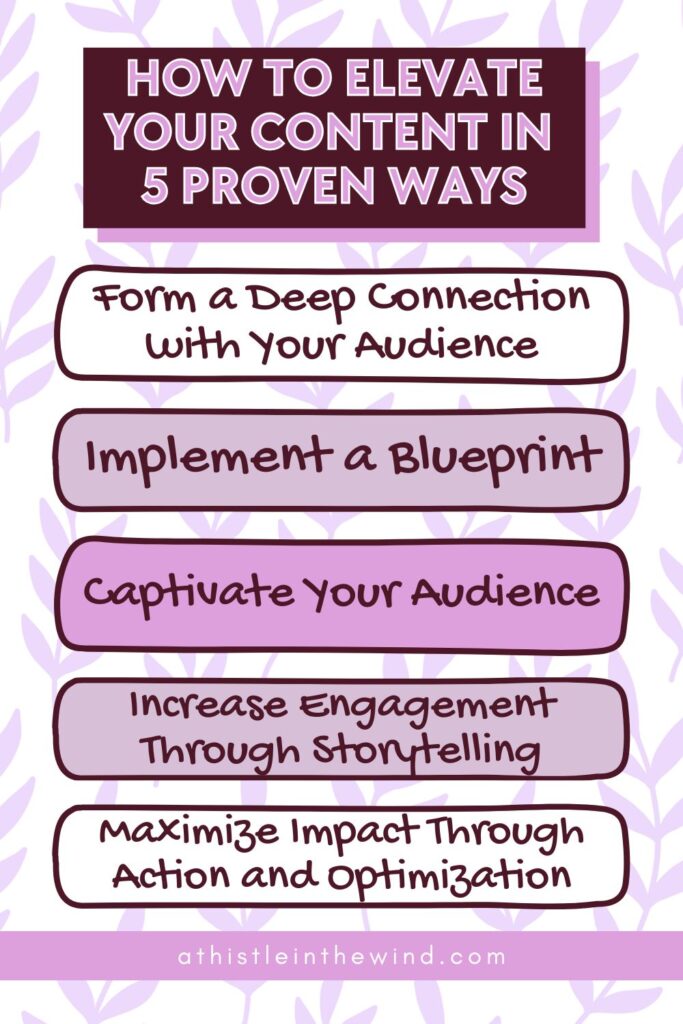How to Elevate Your Content in 5 Proven Ways

So, after my last blog on how to optimize your blog posts, I thought that the next logical topic would be on how to elevate your content. Because let’s be real: in the era of massive AI-generated blogs, you need to find a way to make your content stand out.
When the dust settles on AI, we’re going to be seeing a rise in more authentic voices, and the sooner you get your content to be as unique and true to your voice and brand as possible, the sooner you’ll be able to shine. But how do you do this?
Especially, if you’re new in the space and want to write content that doesn’t just sound different, but something that actually works with the Google (and AI) algorithm. Well, that’s exactly what we’re going to talk about today.
In this blog, let’s look at tried and tested methods that elevate your content, help you capture people’s attention, and most importantly: rank on Google. So, let’s begin.
1. Form a Deep Connection with Your Audience
I know, this one sounds pretty obvious, but it’s harder than you think (especially if you’re a tech bro who thinks you went wrong if you wrote a book instead of a blog post). In reality, effective content is built on the basis of understanding who your target audience is. I like to keep my blogs conversational, with some humor sprinkled in between.
My reason behind this is pretty simple: I know my audience consists primarily of writers and bloggers—people looking for tips, or here for the vibes really. So, I expect that you’ll get my references to certain writers and books. However, when I’m talking about something technical like AI, I make sure that my blogs are more explanatory because:
- That’s probably not something you’re into but are forced to read up on because that’s how things are now, and
- There’s a lot of misinformation about the subject right now, and I try to be as factual as possible.
And this is basically what it is. I may not know your favorite colour, but I do know what topics you’d need more explanation in. This is like the foundational layer of good writing. If you’re not focusing on what your audience cares about, your messaging will fail to resonate.
Listen and Empathize First
Have you ever wondered why a lot of blog posts start with talking about the problem you’re facing? Well, that’s because talking and empathising with someone’s problem before grandstanding does wonders.
From a psychological standpoint, people vibe with people who don’t make everything about themselves, especially if they’re asking them a question or for advice. Now, this piece of advice is more for businesses and I’ll admit that I do give you guys an update at the beginning of most of my blogs. But I do that because I get emails from you guys, comments too and I’m not always able to respond or even approve of a comment on time. So, that’s just my way of making sure that the three people who asked about something, for example, get an answer in my blog directly.
Because it feels good, doesn’t it? People like to be heard, and these are a few ways you can ensure that.
2. Captivate Through Presentation and Structure
Your content could contain the best information on the web, but if the presentation falls flat, your visitors won’t stay or convert. The ability to create curiosity and desirable presentation factors is what makes the magic happen.
Optimize Your Title to Lure Readers
Treat your titles like the gateway to your content. Without an effective title, gaining attention is extremely difficult, regardless of the quality of your blogs. Your title plays a significant role in creating interest. It should grab attention, compel visitors to read, and create curiosity.
If three articles contain the same information, the one with the optimized title is most likely to be clicked.
For example, a title like “How to Get 10,000 Monthly Views on Your Blog” is far more effective at getting readers than a straightforward title like “How to Get Great Views on Your Blog.”
Master Content Delivery and Readability
A major error bloggers make is presenting information as a solid block of text. This eliminates the luxury of “scan now, read later,” which is vital for busy people, such as students rushing to class or business owners with a hundred things to do.
Your blog title might get them through the door, but the presentation is what makes them come back for more.
Avoid solid blocks by dividing your content into subheadings.
Format Using the Hook, Story, Offer Method
To ensure structure actively guides the reader, consider using the powerful “Hook, Story, and Offer” format.
- The Hook: The first thing a potential reader sees after the title. If they clicked, they expect you to deliver on the title’s promise. A good hook is a captivating first sentence that entices the user to scroll back up and start reading your introduction in full. Never assume you have their attention—you must capture it immediately.
- The Story: This element works to connect the hook with the offer. It doesn’t have to be a fictional tale. It can be a metaphor, a real-life example, or even the story you anticipate the reader is currently experiencing. So long as the narrative relates back to the main point, it keeps the reader grounded.
- The Offer: This section differs based on its location. In the introduction, the offer should tease the information you are about to provide, maintaining just enough mystery to compel them to continue reading. Throughout the body of your content, the offer must be present, delivering the promise of your title. This is how you earn engagement, shares, and brand loyalty.
By implementing this structure, you capture attention, keep the audience engaged, and deliver precisely what they came for, ensuring your content has a permanent spotlight.

3. Enrich Engagement Through Storytelling
Great content is not solely about the message itself; it hinges significantly on how that message is delivered. You need to move beyond a passive experience and truly captivate your audience.
Use Storytelling to Create Relatable Narratives
Never underestimate the raw power of a well-told story. In both B2B and B2C environments, stories are remembered and shared long after the initial encounter. They are powerful tools for creating connections and making sense of information.
To make complex ideas stick, create character-driven narratives with emotional depth. This transforms raw data into a compelling narrative that drives action and makes it easier for your audience to understand and retain key points.
I said this earlier too—you need to balance your content with humor and excitement. Think about how you would tell a story. Use that same approach in your content.
Show, Don’t Just Tell
Visuals and design are non-negotiable elements. Investing in high-quality visuals, thoughtful design, and interactive elements ensures your content is much more engaging. A beautifully presented piece captures and retains attention, ensuring your core insights are not lost in an overwhelming sea of text.
When choosing images, avoid adding them merely for the sake of breaking up text. You are a visual being, and content is incomplete without a complimenting image. An image should genuinely enhance the article.
If you are discussing successful advertising campaigns, for example, show an image of one. An image provides that added benefit of making the content visually appealing, acting as the icing on the cake.
4. Implement a Strategic Blueprint
This isn’t a writing tip per say, but it’s a pretty efficient technique I’ve been using this year to write better content. Basically, I plan stuff in advance. At the moment it’s on a quarterly basis but it’s done wonders.
Here’s what you do.
Document Your Strategy for Alignment
Studies surprisingly show that only 39% of B2B marketers have a documented strategy, with nearly a quarter operating without one at all. If you fall into that group, now is the moment for change. A documented strategy ensures you never forget the mission, the target audience, and key priorities, setting the stage for content that truly resonates.
By clearly defining goals and outlining the performance indicators that matter most, you ensure smart resource allocation and maintain accountability across the board.
Prioritize Quality Over Mere Volume
While maintaining consistency is important, churning out a bunch of low-quality pieces is far less effective than publishing fewer, high-quality works. High-quality content is naturally more likely to be shared, attract valuable backlinks, and improve your search engine rankings.
To maintain this standard, you need to make sure that your content is thoroughly researched and provide genuine value. Once the research is complete, you can edit ruthlessly, refining your content to eliminate errors and enhance readability.
Embrace Iteration and Consistency
Consistency helps build trust and authority with your audience; regularly publishing content keeps them engaged and encourages return visits. Trust me, this one works. At this point, I’ve been posting regularly for eleven months and it’s done wonders for me.
You should set realistic goals for how often you can publish high-quality content and stick to that schedule, often by planning ahead with a content calendar.
Want to create a content planner but don’t know where to start? Check out: How to Plan A Content Calendar (and Stick to It): A Guide

5. Maximize Impact Through Action and Optimization
Even the most beautiful and well-told story must have a measurable impact and a clear path for the reader to follow. To truly elevate your content, you must ensure it is actionable, fully optimized, and rigorously tracked.
Make Content Actionable
Your readers arrive at your material because they want a solution. Actionable content that presents and explains the necessary steps clearly will drive engagement and keep your audience returning.
For complex topics, you might walk the reader through it properly. That’s why there are so many step-by-step guides and tutorials available online. Always try to show people how to do something as opposed to simply telling them to do it. This is why I’m always giving examples and explaining stuff on my writing blogs.
Be Clear, Concise, and Relevant
You need to simplify and clarify your content so that the message is easily digestible. Remove complex language and unnecessary jargon to ensure your content is straightforward and to the point.
While many marketers focus on word count over quality, believing that more words equal a better answer, this is often incorrect. If you can deliver the answer with clarity in 400 words, it will be significantly stronger than a 2,000-word article that constantly veers off on tangents.
Before you begin, ask yourself how long the piece needs to be to effectively cover the topic.
Utilize SEO and Expand Your Reach
Search Engine Optimization (SEO) is crucial for increasing visibility and driving organic traffic. To rank higher, you need to identify relevant keywords and phrases your audience is searching for through diligent keyword research.
Beyond that, optimize your content using on-page SEO best practices: proper use of headings, rich meta descriptions, alt tags for images, and internal linking. Crafting compelling, keyword-rich titles will also attract crucial clicks.
And that’s it, essentially! This one turned out longer than I hoped, but hopefully this’ll tell you how to elevate your content. Let me know what you think!


One Comment
Lucy Marks
Honestly, this is really fascinating to read. Can you do more guides like these? Maybe break it down and differentiate between solopreneurs, sides hustles and small businesses?